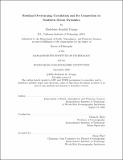| dc.contributor.advisor | Glenn R. Flierl. | en_US |
| dc.contributor.author | Youngs, Madeleine Kendall. | en_US |
| dc.contributor.other | Joint Program in Physical Oceanography. | en_US |
| dc.contributor.other | Massachusetts Institute of Technology. Department of Earth, Atmospheric, and Planetary Sciences. | en_US |
| dc.contributor.other | Woods Hole Oceanographic Institution. | en_US |
| dc.date.accessioned | 2021-01-05T23:16:26Z | |
| dc.date.available | 2021-01-05T23:16:26Z | |
| dc.date.copyright | 2020 | en_US |
| dc.date.issued | 2020 | en_US |
| dc.identifier.uri | https://hdl.handle.net/1721.1/129068 | |
| dc.description | Thesis: Ph. D., Joint Program in Physical Oceanography (Massachusetts Institute of Technology, Department of Earth, Atmospheric, and Planetary Sciences; and the Woods Hole Oceanographic Institution), 2020 | en_US |
| dc.description | Cataloged from student-submitted PDF of thesis. | en_US |
| dc.description | Includes bibliographical references (pages 135-145). | en_US |
| dc.description.abstract | Over the last 20 years, our understanding of the meridional overturning circulation has improved, but primarily in a two-dimensional, zonally-averaged framework. In this thesis, I have pushed beyond this simplification and shown that the additional complexity of meanders, storm tracks, and other zonal asymmetries is necessary to reproduce the lowest-order behavior of the overturning circulation. First I examined the role of basin width for determining whether the Atlantic or Pacific oceans experience deep convection. I used a two layered model and a rectangular single-basin model to show that the basin width, in combination with scalings for the overturning circulation make the overturning relatively weaker in the wider basin, priming it for a convection shut down. | en_US |
| dc.description.abstract | In addition to this large-scale work, I have examined Southern Ocean-like meanders using a hierarchy of idealized models to understand the role of bottom topography in determining how the large-scale circulation responds to climate change scenarios. These are useful because they preserve the lowest-order behavior, while remaining simple enough to understand. I tested the response of the stratification and transport in the Southern Ocean to changes in wind using a highly-idealized two-layer quasi-geostrophic model. In addition to showing that meanders are necessary to reproduce the behavior of the Southern Ocean, I found that strong winds concentrate the baroclinic and barotropic instabilities downstream of the bottom topography and weaken the instabilities elsewhere due to a form-drag process. With weak winds, however, the system is essentially symmetric in longitude, like a flat-bottomed ocean. | en_US |
| dc.description.abstract | This result is consistent with observations of elevated turbulence down-stream of major topography in the Southern Ocean. My next study investigated a more realistic Southern Ocean-like channel, with and without bottom topography, and examined the three-dimensional circulation in order to understand where vertical transport occurs and develop a picture of the pathways taken by each individual water parcel. I found that the vertical transport happens in very isolated locations, just downstream of topography. Finally, I added a biogeochemical model to my simulations and found that carbon fluxes are enhanced near topography, again highlighting the role of zonal asymmetries. | en_US |
| dc.description.statementofresponsibility | by Madeleine Kendall Youngs. | en_US |
| dc.format.extent | 145 pages | en_US |
| dc.language.iso | eng | en_US |
| dc.publisher | Massachusetts Institute of Technology | en_US |
| dc.rights | MIT theses may be protected by copyright. Please reuse MIT thesis content according to the MIT Libraries Permissions Policy, which is available through the URL provided. | en_US |
| dc.rights.uri | http://dspace.mit.edu/handle/1721.1/7582 | en_US |
| dc.subject | Joint Program in Physical Oceanography. | en_US |
| dc.subject | Earth, Atmospheric, and Planetary Sciences. | en_US |
| dc.subject | Woods Hole Oceanographic Institution. | en_US |
| dc.title | Residual overturning circulation and its connection to Southern Ocean dynamics | en_US |
| dc.type | Thesis | en_US |
| dc.description.degree | Ph. D. | en_US |
| dc.contributor.department | Joint Program in Physical Oceanography | en_US |
| dc.contributor.department | Massachusetts Institute of Technology. Department of Earth, Atmospheric, and Planetary Sciences | en_US |
| dc.contributor.department | Woods Hole Oceanographic Institution | en_US |
| dc.identifier.oclc | 1227036952 | en_US |
| dc.description.collection | Ph.D. Joint Program in Physical Oceanography (Massachusetts Institute of Technology, Department of Earth, Atmospheric, and Planetary Sciences; and the Woods Hole Oceanographic Institution) | en_US |
| dspace.imported | 2021-01-05T23:16:25Z | en_US |
| mit.thesis.degree | Doctoral | en_US |
| mit.thesis.department | EAPS | en_US |
